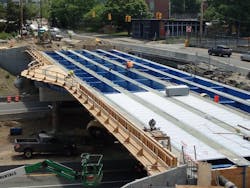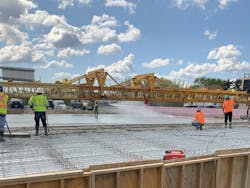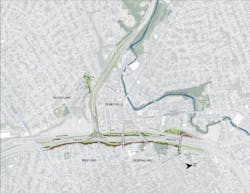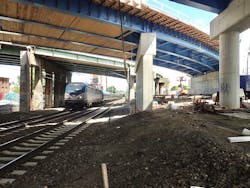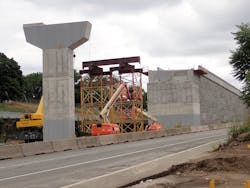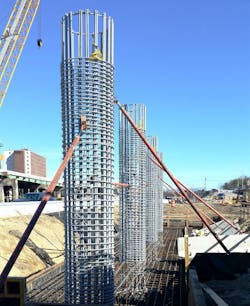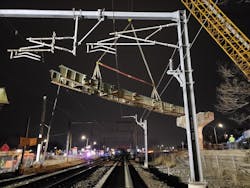Providence, Rhode Island megaproject continues to make forward strides
The U.S. Route 6 and State Route 10 Interchange in Providence, Rhode Island is a three-leg directional interchange that serves as a critical east-west regional link for automobile and truck traffic along Interstates 295, 95, and 195.
Nearly 100,000 trips are made through the interchange each day with two-thirds of those trips originating or destined for points outside of Providence. Additionally, the Amtrak Northeast Corridor runs along the entire west side of the project area.
The intent of this project is to reconstruct the entire Route 6/10 Interchange with a replace-in-kind approach and provide improved connectivity within neighborhoods. A total of nine bridges (not including viaduct ramps) are being replaced, seven of which are rated structurally deficient.
Including design, construction, oversight, and contingencies, the total estimated cost is $410 million. The work is managed by the Rhode Island DOT (RIDOT) with secured funding through the RhodeWorks legislation. Awarded in December 2017, the project will take approximately five-and-a-half years to complete with a completion date of November 2023.
A little history
The Route 6/10 Interchange is a major interchange in the greater transportation system connecting Rhode Island, Connecticut, and Massachusetts. The limits extend just west of downtown Providence in a neighborhood known as Olneyville. Originally built in 1950 to alleviate traffic congestion in the Olneyville Square shopping area, the Olneyville Expressway was considered a modern traffic facility utilizing the concept of “braided” roadways and touted efficiency of space with roads integrated both horizontally and vertically in a three-level configuration. Due to the steady traffic growth and increased number of freight trucks, the interchange no longer met highway safety and serviceability standards. These issues were compounded in the 1960s and 1970s when regional highways were connected to Route 6 and Route 10, causing the interchange to be functionally obsolete. Furthermore, as the urbanized limits of Providence expanded and subsumed Olneyville, community barriers imposed by the highway corridors were realized.
RIDOT has spent millions of dollars on stopgap maintenance measures to address these issues and allow the interchange to remain operational.
In addition to replacing the aging bridges, the project includes:
Relocating and lowering the Route 6/10 roadway to reunite the neighborhoods east and west of the corridor that are currently separated by the elevated highway.
Constructing a flyover ramp to provide the missing movement from Route 10 northbound to Route 6 westbound, improving regional traffic flow and reducing local traffic congestion
in Olneyville.
Replacing bridge crossings over Route 10 for three city streets. The roadways are wider boulevards that include new multiuse paths providing separate, safe routes for pedestrians and bicyclists. These new crossings, combined with lowering the existing elevated highway, substantially improve the connectivity of the adjacent neighborhoods.
Improving roadway geometry to meet current AASHTO design standards and incorporating current safety recommendations such as taller AASHTO TL-4 barriers as well as other barriers and guardrail conforming to AASHTO MASH criteria.
Creating new bicycle/pedestrian paths extending through the north-south project limits, including two additional crossings over Amtrak’s Northeast Corridor. These shared-use paths enhance connectivity between area neighborhoods and provide a significant connection to the regional bikeway system.
Incorporating aesthetic features such as more green space, streetscape elements, and landscape materials chosen to enrich the visual quality of the corridor and to provide environmental benefits to the land.
Procurement & Partnering
RIDOT chose to use a design-build (D/B) procurement method to fast-track the project. Looking to maximize its investment, deliver demonstrable improvements to area motorists in the shortest possible timeframe, and recognizing the constructability challenges at the site, RIDOT used a two-step (qualification phase and a proposal phase) best-value selection process.
In December 2017, the 6/10 Constructors Joint Venture (6/10 JV)—a four-company team led by Barletta Heavy Division, with O&G Industries Inc., D.W. White Construction, and Aetna Bridge Company—was awarded the project. The 6/10 JV had both the highest scoring technical proposal and the lowest bid price with a construction cost estimate of $247 million.
With its size and complexity, the 6/10 Interchange project is noteworthy for several reasons. It entails the design and construction of 12 new bridges: a pair of two-span steel plate girder structures, four single-span steel plate girder structures, four multi-span curved steel plate girder ramp structures, a multi-span twin steel box beam curved flyover ramp structure, and a pedestrian truss bridge spanning Amtrak; 29 retaining walls; 2 miles of roadway reconstruction; 350,000 cu yd of earthwork; 28,000 linear ft of drainage; creative lighting; intelligent transportation systems; and last but not least, landscaping.
Success thus far has been greatly due to the synergy between RIDOT, the Federal Highway Administration (FHWA), and the D/B Entity. The cohesive team made up of FHWA RI Division lead engineer, RIDOT project managers and construction managers, CHA as the RIDOT Owner’s Representative, HW Lochner as RIDOT inspection services, and the 6/10 Constructors team have balanced cost, function, efficiency, and mobility in delivering the project. Participation also includes important shareholders, specifically the city of Providence and local Amtrak project managers. Amtrak personnel have worked diligently with RIDOT and the D/B Entity to review and approve bridge designs and maintain continuity of train service during construction.
Design
One of the biggest challenges and successes for the project has been managing the numerous document submittals and implementing a review and approval system that meets the demands of a large, fast-paced megaproject. The project team is employing Bluebeam and SharePoint for document tracking and increased transparency between all parties. This streamlined process simplifies the paper trail, providing a better foundation for improved communications and collaboration. SharePoint provides consistent access to up-to date versions of documents, the ability to track submittals, and quick access to all project materials, ultimately resulting in time savings for the project schedule. The D/B Entity and RIDOT collaborated to develop a SharePoint site and workflows that allow for the efficient exchange of information.
Preliminary design work and early action field work (survey, subsurface investigations, soil sampling, and utility coordination) began in January 2018, and by March 2018 the design team—led by AECOM with VHB, Commonwealth Engineers, Crossman Engineering, McMahon, and Green International—had over 50 design engineers working on 30 drawing packages. The large majority of the design work was performed over an 18-month period. As of June 2020, it stands at a 95% level of completion.
Phase 1 Construction Milestones
In order to keep the highway as well as critical on and off-ramps open during construction, a temporary roadway was constructed to carry Route 10 northbound and the off-ramp to Westminster Street. Route 10 and Route 6 traffic were moved away from the center of the interchange, freeing up a large work zone for construction of the new highway and bridge segments. Traffic on the Hartford Avenue, Plainfield Street, Broadway, and Westminster Street bridges were all shifted to one side of the existing bridge, essentially enabling for half-width bridge construction. Interim permits from the Rhode Island Department of Environmental Management were required for this work to commence. The Route 10 northbound traffic shift and temporary Westminster off-ramp were opened to traffic in November 2018.
One of the initial challenges faced during the project was the coordination with affected utilities on Westminster Street and the Broadway bridges. The design and work plan devised by the 6/10 JV was crafted to minimize the disruptions to both public and private utilities, by improved utility phasing. The phasing that was developed eliminated the need to relocate utilities on temporary bridges and also allowed for utilities to be relocated only once. Proactive coordination with the utility companies was vital to maintaining the project schedule. Working in partnership with the affected utility companies, monthly meetings were held, resulting in shorter durations than anticipated.
A significant amount of foundation, pier, and abutment construction took place in 2019. Bridge foundations varied across the site and consisted of both spread footings and deep pile foundation systems. The presence of deep compressible layers of organics dictated a site-specific seismic study and the design/construction of taper tube pipe piles for the bridges in the heart of the interchange. Micropiles were used for select foundations where overhead obstructions prevented construction of driven piles.
In November 2019, traffic was shifted onto the new south side of both Hartford Avenue and Plainfield Street bridges. This represented a major RIDOT milestone with the first opening of new bridge infrastructure as part of the overall reconstruction project. The demolition and construction of the northern portion of both Hartford and Plainfield bridges began in December 2019.
The Huntington Avenue Viaduct ramps are constructed over Amtrak’s Northeast Corridor. This work required extensive coordination with Amtrak engineering and safety personnel. The contractor had to work within nighttime power outages for all work in the right-of-way.
June 2020 marked the third significant traffic shift, with vehicles relocated onto the newly constructed portion of the viaduct. This shift removed Route 6 westbound traffic from an existing part of the viaduct that is considered the bridge in the most advanced level of deterioration.
Phase 2 Ongoing Construction
As of Summer 2020, work is ongoing at 11 of the 12 bridges and has continued throughout the COVID-19 pandemic. Reduced traffic volumes during 2020 have allowed the 6/10 JV to close additional lanes during off-peak periods. However, the project is experiencing some material procurement delays due to the pandemic. It is anticipated that the Hartford Avenue and Plainfield Street bridges carrying Route 6 will be completed in Fall 2020, as well as Ramps B and C. Construction on the Westminster Street, Broadway, Tobey, and Harris Avenue bridges will be ongoing for another 18 months.
Construction on the viaduct and Ramp D will continue for another three years. The Summer and Fall of 2020 will see significant progress of the new Route 6WB Flyover bridge. The trapezoidal steel boxes are being fabricated with erection scheduled for late summer and early fall.
